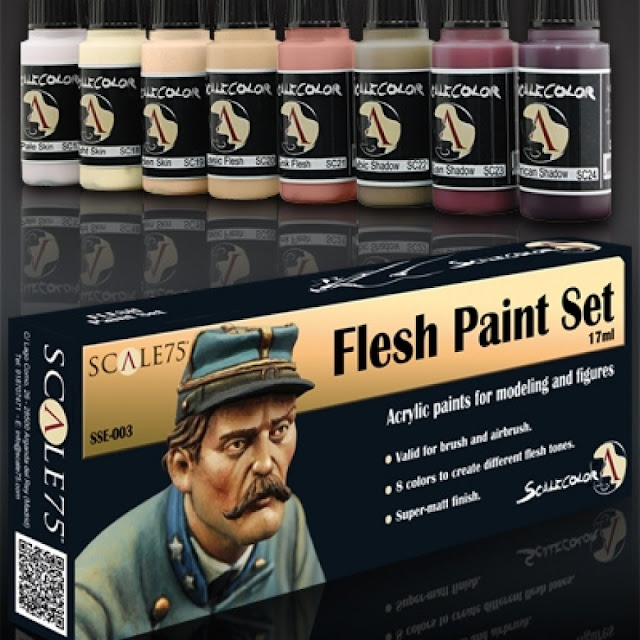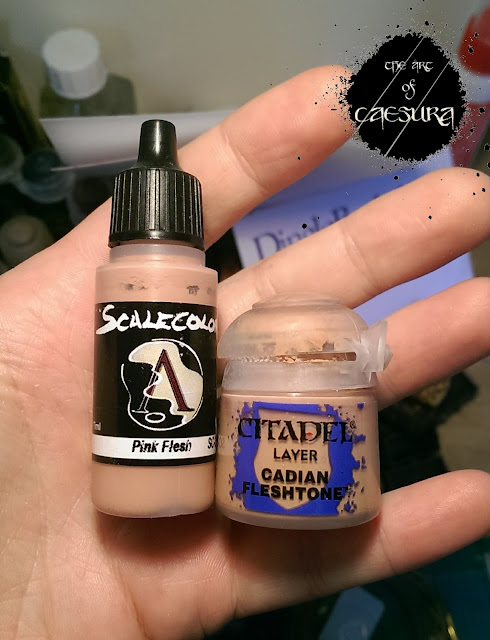The complexion of a light-skinned face divides into three zones:
The forehead has a light golden colour because it's freer of muscles and surface capillaries.
The ears, cheeks and nose all lie within the central zone of the face.
Those areas have more capillaries carrying oxygenated blood near the
surface, causing the reddish colour...
The zone from the nose to the chin (where there are relatively more veins carrying blue deoxygenated blood) tends toward a bluish, greenish or greyish colour. Some artists accentuated this subtle bluish or greenish hue to bring out the reddish lip colour.
Color and Light (page 156) - James Gurney
Welcome all to The Art of Caesura!
So I finished all the models in Warhammer Quest Silver Tower!! Wooohooo!! Now for something a bit different!
This week I'm going to do something I've never done on the blog before: write a review!! I've been wanting to write my thoughts on Scale 75's Flesh Paint Set for over a year now, but I really wanted to have loads of experience with them first.
Why am I writing this review?
NOT because:
I'm getting paid to (I wish!)
I'm a professional painter (long term readers know me as enthusiastic, and I would rate myself as strongly intermediate)
I hate Games Workshop and think no-one should buy their stuff (I've been almost exclusively using their paints for 15 years now)
Anyway, the reason I'm writing it is because I bet there are tons of normal people like me out there who have only ever used Citadel paints, just because that's what they're used to. I've got nothing against Citadel paints, but when I saw what a guy over on the Conan forums was achieving with these Scale 75 paints on his Skin tones, I decided to branch out of my Citadel and give these a try.
For those of you not fond of reading, I will direct you over here (it is NOT my content, but Vince is a hugely competent painter, has given me permission to post this here, and does a good job of showing off what these paints can do in his video)
Now, my thoughts...
I am one of those painters who likes to get by with the minimum number of different paints and plenty of mixing. So buying a whole set devoted to flesh tones was new to me. I felt it warranted, however, because I find flesh-tones difficult to mix from scratch and they often form focal points like faces and hands on models, so are worth doing well.
I have included a gallery at the end of this review showing a range of skin tones that I achieved exclusively with these paints.
What's in the box?
Lets start from the beginning with these paints. The set contains 8 paints, a quick guide on how to use them and examples of the flesh-tones that can be achieved.
The Bottles:
The bottles themselves are dropper bottles (as opposed to the pots I'm more used to) and while many people prefer bottles (less paint wastage) I am a slower convert. I like to use very small amounts of paint at a time, and I find that I have less control of this with the bottles - even the smallest drop I can squeeze out is a bit too much at times.
It was a nice touch that the bottles come properly sealed (there's a plastic partition at the opening of each bottle that you pierce the first time you use it) so you don't have to worry about an old paint having started to dry out, which sometimes happens with the pots. Puncture the top with a pin, put the lid back on and shake for all you're worth to mix in the acrylic medium.
The Consistency:
Out of the bottle, these paints are much thicker (more viscous) than Citadel layer paints. Apparently, this is because they have a retardant medium in them so that you can blend more before they dry out. Although the consistency is thicker, they are more translucent than many Citadel paints, again to facilitate the use of thin layers.
Applying paint to the model is a joy with these paints. Once you get the right consistency (with water or medium) the paint flows very nicely with no lumps or streaks. Due to the translucency, I have found it easier to base coat with a different paint range and use these for layering / glazing.
The Colour Range:
In my opinion, these paints are more nuanced than Citadel's. "African Shade" has really nice plum tones, "Arabic Shadow" has green-olive tones hiding in it and "Light Skin" has some bright yellows. Skin painted with these paints feels more alive as a result.
Citadel is very good at making consistent paints with basically a pure tone. The benefit of that is that you can easily reproduce effects by following the steps they suggest (in White Dwarf or their app). But you lose some of the nuance and vitality that is quite easily achieved with these Scale 75 paints.
The Finish:
The ultra-matte finish is hands down my favourite element of these paints. Skin looks so much better when it has realistic surface scattering and is not reflecting light like plastic. Plus this has the added bonus of really contrasting the addition of gloss varnish (for drool / sweat effects).
Overall:
I really love these paints! With the addition of a bit of Reikland Fleshshade, I have been using this Scale 75 Flesh Paint set pretty exclusively for all of the skin I have painted in the past year!
I would describe these paints as a bit more specialized than Citadel's range. That's not to say they're hard to use, but rather they're not for every situation.
Here is a selection of a range of skin-tones that I have painted with these paints over the past year or so (Click on the titles to be teleported back to the post with details on how the skin tone was accomplished):
Dark skin:
Ruddy Skin:
Mediterranean / Olive Skin:
Eumelanin Skin:
Light Skin:
If you have any questions about these paints, please don't hesitate to ask - I'm always happy to provide my thoughts!
Till next week on The Art of Caesura!
Listening: The Wanting Comes in Waves - The Decemberists
Watching: Jumanji: Welcome to the Jungle (2017) - Kasdan
Reading: Saga: Book 2 - Brian K. Vaughn
Gaming: The Wolf Among Us - Telltale Games
Next Week:
Unto the Underhive!
























I am grateful to the owner of this site which really shares this wonderful work of this site. That is actually great and useful information. I'm satisfied with just sharing this useful information with us. Please keep it up to date like this. Thank you for sharing.
ReplyDeletethis paint is garbage. you said it yourself and i quote "Due to the translucency, I have found it easier to base coat with a different paint range and use these for layering / glazing. " I tried scale 75 on a white primed flat surface and it took me a dozen coats to cover and somewhat remove the visible brush strokes. Vallejo, AK, Citadel all within two, three coats maximum cover beautifully. They don't need another base layer of a different brand. I really don't understand the hype with this inferior brand. Your comment about layering and glazing is the same as saying this cars amazing it just doesn't drive in reverse.
ReplyDeleteHey Anonymous,
DeleteThanks for popping by. I totally agree that these paints are definitely not "Jack of All Trades" paints like the brands that you mention. They are not designed for base coating, and so you're right it would take many thin layers to build up a solid coat (see Vince's video that I embedded) so I take the cheater method of applying a different brand for the base coat and use these S75 paints to add life and nuance.
Paints like Cadian Fleshtone or Bugman's Glow may cover with fewer coats, but for me this isn't always the objective of painting. When it calls for it, I like to paint my miniatures cheeks flush with vitality, or shadows on their skin a matte plumb. These are the kinds of applications that this paint range excels at, but I'm sorry if my post was misleading.
Thanks again.